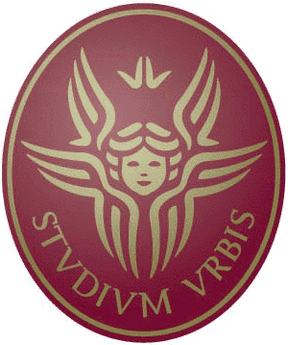
Sapienza University of Rome
The Sapienza University of Rome (Italian: Sapienza – Università di Roma), formally the Università degli Studi di Roma "La Sapienza", abbreviated simply as Sapienza ("wisdom"), is a public research university located in Rome, Italy.[7] It was founded in 1303 and is as such one of the world's oldest universities,[8] and with 122,000 students, it is the largest university in Europe.[9] Due to its size, funding, and numerous laboratories and libraries, Sapienza is a major education and research centre in Southern Europe.[10] The university is located mainly in the Città Universitaria (University city), which covers 44 ha (110 acres) near the Tiburtina Station, with different campuses, libraries and laboratories in various locations in Rome.
"Sapienza" redirects here. For other uses, see Sapienza (disambiguation).
Sapienza was founded the 20th of April 1303 by decree from Pope Boniface VIII as a Studium for ecclesiastical studies under more control than the free-standing universities of Bologna and Padua. In 1431 Pope Eugene IV completely reorganized the studium and decreed that the university should expand to include the four schools of Law, Medicine, Philosophy, in addition to the existing Theology. In the 1650s the university became known as Sapienza, meaning "wisdom", a title it still retains.[11] After the capture of Rome by the forces of the Kingdom of Italy in 1870, La Sapienza rapidly expanded as the chosen main university of the capital of the newly unified state. In 1935 the new university campus, planned by Marcello Piacentini, was completed.[12]
Sapienza teaches and conducts research in all pure and applied sciences and humanities. It is often considered the best in the world for classics and ancient history.[13][14] Sapienza houses 50 libraries with over 2.7 million books, most notably the Alessandrina University Library, built in 1667 by Pope Alexander VII, housing 1.5 million volumes.[15] It in addition has 19 museums, a botanical garden, and three university hospitals.[16] Sapienzas alumni includes 10 Nobel laureates, Italian prime ministers, one pope, Presidents of the European Parliament and European Commissioners, as well as several notable religious figures, supreme court judges, and astronauts.[17]
Academics[edit]
Since the 2011 reform, Sapienza University of Rome has eleven faculties and 65 departments. Today Sapienza, with 140,000 students and 8,000 among academic and technical and administrative staff, is the largest university in Italy. The university has significant research programmes in the fields of engineering, natural sciences, biomedical sciences and humanities. It offers 10 Masters Programmes taught entirely in English.
University rankings
151-200 (2020)
113 (2021-2022)
81 (2020)
134 (2024)
197 (2022)
=114 (2021)